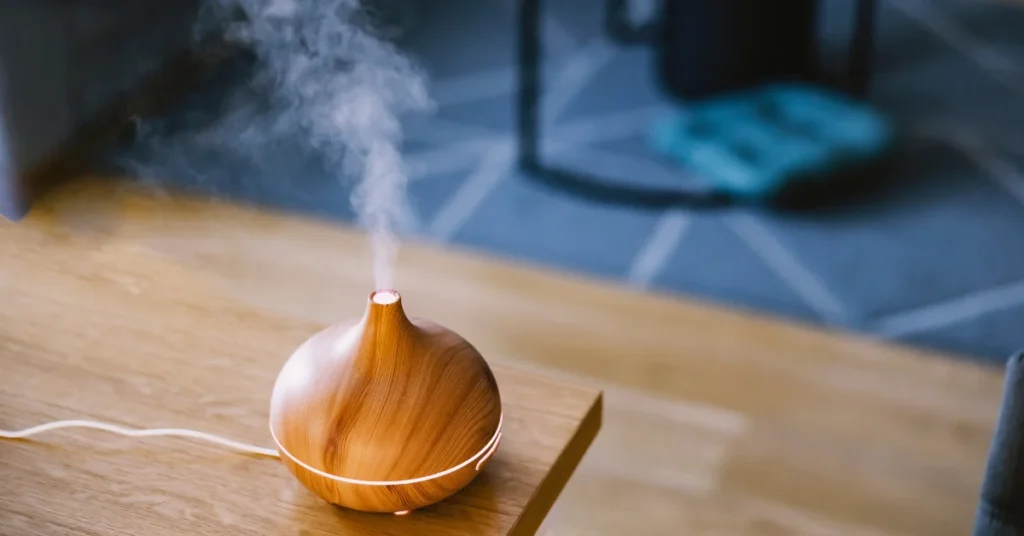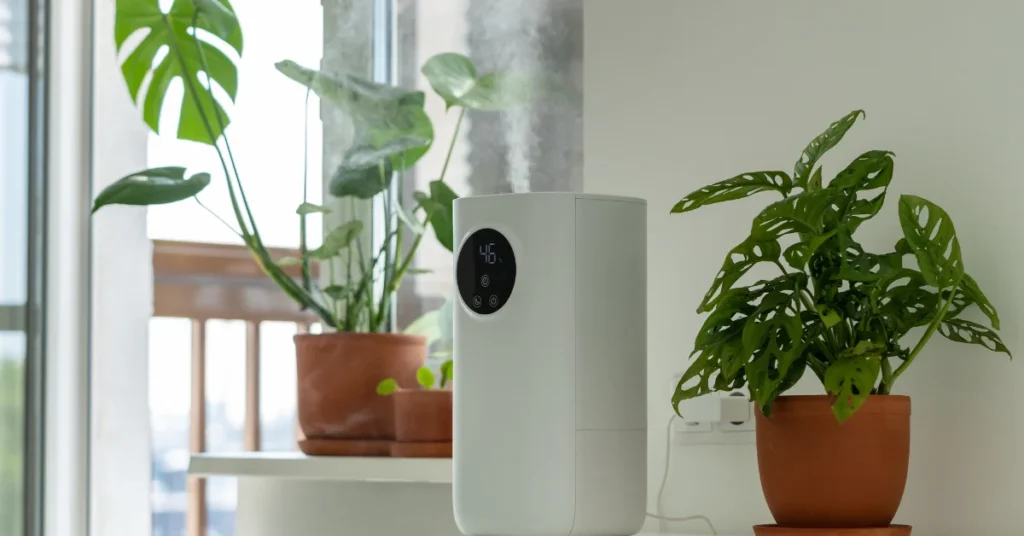You might be wondering, “Can I run my Vicks humidifier while my air conditioner is on?” The short answer is yes, and in many cases, it’s actually a great idea!
Here’s why:
1. Balancing Dry Air from AC
Air conditioners are great at keeping you cool, but they also remove moisture from the air, which can lead to a dry environment. If you’ve ever noticed your skin feeling drier or your throat getting scratchy when the AC is running, that’s because the air has lost some of its humidity. A humidifier helps restore moisture, making your space more comfortable and easier to breathe in, especially during those hot summer days.
2. Improving Air Quality
Using a humidifier with your air conditioner can improve overall air quality. Proper humidity levels reduce the likelihood of dry skin, nosebleeds, and respiratory irritation. Plus, it’s helpful if you suffer from allergies, as humidity can help clear out allergens like dust and pollen that tend to thrive in dry air.
3. Tips for Using a Humidifier with AC

If you’re running both devices together, here are some things to keep in mind:
- Find the right balance: You don’t want the air too dry or too humid. Ideally, the humidity level in your home should be between 30% and 50%. You can buy a simple hygrometer to monitor the levels, ensuring you’re not over-humidifying the space.
- Adjust the humidifier settings: Start by using the low setting on your Vicks humidifier when the AC is running. This will help maintain comfortable moisture levels without overloading the room with too much mist.
4. Energy Efficiency
You don’t need to worry about skyrocketing your energy bill by using both your AC and humidifier at the same time. Humidifiers use very little electricity, so they won’t significantly impact your energy consumption.
By using a Vicks humidifier along with your air conditioner, you can maintain a comfortable and breathable environment, even on the hottest days. Now that you’ve got this covered, let’s explore whether you can use a room humidifier with a CPAP machine in the next section. Shall I continue?
Can You Use a Room Humidifier with a CPAP Machine?
If you use a CPAP machine for sleep apnea, you might have noticed that the airflow can sometimes dry out your throat and nasal passages. This leads many people to wonder if a room humidifier like a Vicks model can be used alongside their CPAP machine. The good news? Yes, you can!
Here’s how a humidifier can complement your CPAP machine and some tips for using them together.

1. How a Humidifier Helps with CPAP Use
CPAP machines work by providing a continuous flow of air into your airways while you sleep, but this air is often dry. A room humidifier helps by adding moisture to the air in your bedroom, which can ease common discomforts like dry throat, dry nasal passages, and even nosebleeds. With a humidifier running, the air you breathe while using the CPAP machine will be less dry, making it more comfortable for you.
2. Can I Use Both at the Same Time?
Yes! While CPAP machines often come with built-in humidifiers, using a room humidifier in your bedroom can give the overall air an added moisture boost. Here’s what you need to know:
- Positioning matters: Place the room humidifier a few feet away from your CPAP machine. This will ensure that the extra moisture in the air can circulate evenly without affecting the machine’s airflow.
- Avoid over-humidifying: Be cautious not to over-humidify the room. Too much moisture in the air can create condensation in your CPAP hose, which might make the air feel wet or uncomfortable. Keep your humidifier on a low to medium setting to maintain a comfortable balance.
3. When to Use the Built-In Humidifier vs. Room Humidifier
If your CPAP machine has a built-in humidifier, you can either use it alone or in combination with a room humidifier. However, some users prefer to use only a room humidifier, as the built-in one might feel too strong or may not be adjustable enough for their needs.
Tip: If you notice condensation building up in your CPAP mask or tubing, this might be a sign you’re using too much humidity. In this case, try lowering the settings on both your room humidifier and the built-in one.
4. What About Cleaning?
Be sure to keep your Vicks humidifier clean if you’re using it alongside your CPAP. Regular cleaning will prevent mold or bacteria from growing, which is essential for maintaining healthy air while you sleep.
How to Use a ResMed AirSense 11 Without a Humidifier
The ResMed AirSense 11 is one of the most advanced CPAP machines available, and while it comes with a built-in humidifier, you may wonder if you can use it without one. Yes, you can! However, there are some things to keep in mind to ensure comfort and proper use when skipping the humidifier.

1. Why Use It Without a Humidifier?
Some users prefer not to use the built-in humidifier for a variety of reasons:
- Travel convenience: Not having to bring along the humidifier makes the machine more compact and easier to transport.
- Dry environments: If you live in an area with naturally higher humidity, you might find the humidifier unnecessary.
- Personal preference: Some people simply don’t like the warm air that comes from the humidifier, especially in warmer weather.
2. Challenges of Using a CPAP Without a Humidifier
While it’s fine to use your AirSense 11 without the humidifier, there are a few challenges you might encounter:
- Dry throat and nasal passages: Without the added moisture, the continuous airflow from the CPAP machine can dry out your airways, leading to discomfort.
- Nasal congestion: Some users experience nasal congestion or irritation from breathing dry air for extended periods.
Pro Tip: If you’re not using the humidifier, running a room humidifier (like a Vicks humidifier) in your bedroom can help maintain some moisture in the air to alleviate dryness.
3. Settings Adjustments
If you decide to go without the humidifier, it’s important to adjust your ResMed AirSense 11 settings for optimal comfort:
- Turn off the humidifier setting: In the menu, make sure the humidifier is turned off so the machine doesn’t heat up air unnecessarily.
- Experiment with air pressure settings: Higher air pressures can make the air feel drier. You may need to consult with your healthcare provider to adjust your CPAP pressure settings slightly to make the airflow more comfortable.
4. Alternatives to Using the Humidifier
If dryness becomes an issue but you still want to avoid using the built-in humidifier, here are some alternatives:
- Nasal saline sprays: A quick spritz before bed can help keep your nasal passages hydrated.
- Room humidifiers: As mentioned earlier, using a room humidifier can add moisture to the air without having to rely on the CPAP’s built-in option.
5. When to Add the Humidifier Back In
If you start to experience excessive dryness or discomfort, you may want to reintroduce the humidifier to your ResMed AirSense 11. It’s a simple process to fill and attach the humidifier, and you can always turn it off again when it’s not needed.
Can You Put Vicks in a Humidifier?
Many people associate Vicks products, like VapoRub and VapoSteam, with soothing relief from colds and congestion. So, naturally, you might wonder, “Can I put Vicks in my humidifier?” The answer depends on the type of Vicks product you’re using and the specific model of your humidifier.
Here’s what you need to know:

1. What Vicks Products Are Safe to Use?
Vicks offers products specifically designed for use in certain humidifiers, including:
- Vicks VapoPads: These are medicated pads that are safe to use with Vicks-branded humidifiers that have a slot for them. They release soothing vapors into the air to help ease congestion and coughs.
- Vicks VapoSteam: This is a liquid that can be added to certain Vicks warm mist humidifiers. It works by releasing medicated steam to help with cold and flu symptoms.
2. What Not to Add to Your Humidifier
While it might be tempting to add other Vicks products like VapoRub or essential oils into the water tank, this is not recommended. Adding anything other than water to the tank can damage the humidifier and pose a risk of fire if oils or creams come into contact with the heating elements in warm mist models.
- VapoRub: Vicks VapoRub is a topical ointment meant for external use on the skin or under the nose. Never add it to the water tank of any humidifier, as it can cause the machine to malfunction.
- Essential Oils: These should also be avoided unless your humidifier specifically states that it’s compatible with them. Using essential oils can clog the system and shorten the lifespan of the humidifier.
3. How to Safely Use VapoPads or VapoSteam
- VapoPads: If your Vicks humidifier has a scent pad slot, simply insert a VapoPad into the designated area. As the humidifier runs, it will gently release the menthol vapors into the air.
- VapoSteam: For humidifiers that are compatible with VapoSteam, follow the instructions for adding the liquid to the medicine cup or steam chamber. Do not pour it directly into the water tank.
4. Alternatives to Vicks Products
If your humidifier doesn’t support the use of VapoPads or VapoSteam, you can still enjoy soothing relief by placing a jar of VapoRub nearby or using a different product, like a vaporizer, alongside your humidifier.
Cleaning and Maintaining Your Vicks Humidifier
To keep your Vicks humidifier running smoothly and producing clean, fresh mist, regular cleaning is essential. Neglecting maintenance can lead to mold, bacteria, and mineral build-up inside the machine, which can affect the air quality in your home and shorten the life of your humidifier.
Here’s how to keep your humidifier in top condition:

1. Why Regular Cleaning is Important
Humidifiers create a moist environment that can become a breeding ground for mold, mildew, and bacteria if not cleaned properly. If left unchecked, this can lead to:
- Bad odors
- Potential health risks, especially for people with allergies or respiratory issues
- White dust, which is caused by mineral build-up from using hard water
Tip: Using distilled water instead of tap water can reduce the need for frequent cleaning.
2. Daily Maintenance
To keep your humidifier clean on a day-to-day basis:
- Empty the water tank after each use: Don’t let water sit in the tank when the humidifier is not in use, as stagnant water can breed bacteria.
- Rinse the tank with warm water: This removes any residue or leftover minerals from the day’s use.
- Dry the tank: Leave the tank open and allow it to air dry completely before refilling it for the next use.
3. Weekly Deep Cleaning
A deeper clean should be done once a week to remove any mineral deposits, bacteria, or mold. Here’s how:
- Step 1: Disassemble the Humidifier Unplug the humidifier and carefully remove the water tank, base, and any other removable parts.
- Step 2: Clean the Tank Mix a solution of 1 cup of white vinegar and 1 cup of water. Fill the water tank with the mixture and let it sit for about 20 minutes to loosen any mineral build-up. After soaking, use a soft brush or cloth to scrub the inside of the tank, especially around the edges.
- Step 3: Clean the Base Use the same vinegar solution to wipe down the base, focusing on the areas where water comes in contact with the machine. For more stubborn deposits, you can use a toothbrush to scrub away any white mineral build-up.
- Step 4: Rinse and Dry Rinse all parts thoroughly with water to remove any remaining vinegar. Allow the tank and base to air dry completely before reassembling and refilling the humidifier.
4. Monthly Maintenance
Once a month, it’s a good idea to disinfect your humidifier to kill any bacteria or mold that might be lingering. Here’s how:
- After cleaning with vinegar, fill the tank with a solution of 1 teaspoon of bleach to 1 gallon of water.
- Let the solution sit in the tank for about 30 minutes.
- Rinse thoroughly with water until the bleach smell is gone, then allow the humidifier to dry completely.
5. Preventing Mold and Mineral Build-Up
- Use distilled or demineralized water: This reduces the amount of minerals that can build up inside the humidifier, which means less frequent cleaning.
- Avoid adding anything to the water tank: Stick to water only in the tank—no oils or additives. If you want soothing vapors, use Vicks-approved products like VapoPads in the designated area.
- Keep your humidifier in a dry place when not in use: Proper storage prevents moisture from lingering inside the machine, which can encourage mold growth.
Troubleshooting Common Issues with Your Vicks Humidifier
Even with proper maintenance, you might encounter a few hiccups while using your Vicks humidifier. Don’t worry—most issues are easily fixable with a few simple adjustments. Here are some of the most common problems users experience and how to solve them.

1. Why Isn’t My Vicks Humidifier Producing Mist?
If your humidifier is plugged in but not producing any mist, it can be frustrating. Here are a few things to check:
- Water level: Ensure the water tank has enough water. If the tank is empty or too low, the humidifier won’t produce mist.
- Proper assembly: Double-check that the water tank is securely placed on the base. If it’s not aligned correctly, water won’t flow into the base, preventing mist production.
- Cleaning: Mineral deposits can block the mist outlet. Give the unit a good clean, especially around the base and any openings where mist is released.
- Settings: Make sure the power is turned on and the mist level is set correctly. Some humidifiers have multiple settings (low, medium, high), so ensure you’re not accidentally set to “off” or a low setting.
2. Why Is My Vicks Humidifier Leaking?
A leaking humidifier can be messy, but it’s often a quick fix:
- Tank cap: Make sure the water tank cap is screwed on tightly and not cross-threaded. A loose cap can cause water to leak from the tank.
- Tank placement: Ensure the tank is sitting securely on the base. If it’s not aligned properly, water may seep out from the sides.
- Cracks: Inspect the water tank for any cracks or damage that could be causing leaks. If you find a crack, you may need to replace the tank or unit.
3. Why Is My Vicks Humidifier Producing White Dust?
If you notice a fine white dust settling around your humidifier, it’s usually a sign of mineral build-up from hard water. Here’s how to reduce or eliminate it:
- Use distilled or demineralized water: Switching to distilled water can prevent minerals from being released into the air.
- Use a demineralization cartridge: Some Vicks humidifiers are compatible with demineralization cartridges that help trap and reduce mineral deposits.
- Clean regularly: Frequent cleaning helps minimize mineral build-up, which is often the cause of white dust.
4. Why Does My Humidifier Have a Strange Odor?
If your humidifier smells bad, it’s a sign that it needs to be cleaned. Mold, mildew, and bacteria can build up inside the tank if water sits for too long.
- Daily maintenance: Empty and rinse the tank after each use to prevent stagnant water from causing odors.
- Deep cleaning: Perform a weekly cleaning with vinegar and water, and disinfect with bleach once a month to remove any mold or bacteria that might be causing the smell.
5. Why Is My Vicks Humidifier Too Noisy?
Most humidifiers produce a soft hum, but if your Vicks humidifier is making unusual noises, here’s what could be happening:
- Low water level: A gurgling noise could mean the water level is low. Refill the tank to see if that resolves the issue.
- Tank not seated properly: If the tank is slightly out of place, it may cause vibration or rattling noises. Reposition the tank to ensure it’s sitting securely on the base.
- Build-up in the base: Mineral deposits can cause noise as water flows through the humidifier. A thorough cleaning of the base may solve the problem.
6. Why Is There No Mist but the Unit Is On?
If your Vicks humidifier is on but not producing mist, it may have auto-shutoff features activated or require cleaning:
- Check for auto shutoff: Some models automatically shut off if the water tank is empty or misaligned. Refill and properly align the tank, then restart the unit.
- Clean the heating element or mist outlet: Blockages from mineral deposits can prevent mist production, so cleaning those parts may help.
Conclusion
Using a Vicks humidifier is an excellent way to keep your home comfortable, especially during dry seasons or when dealing with respiratory issues. With this guide, you now know how to set up, refill, and maintain your humidifier for optimal performance. Whether you’re using it alongside an air conditioner, in a bedroom with a CPAP machine, or simply to add moisture to your home’s air, you’re fully prepared to get the most out of your device.By following the simple cleaning and maintenance tips, you’ll ensure your humidifier stays in top shape for years to come, providing fresh, clean mist whenever you need it. Plus, now you know exactly what’s safe to put in your humidifier and how to troubleshoot any common issues that may arise.




